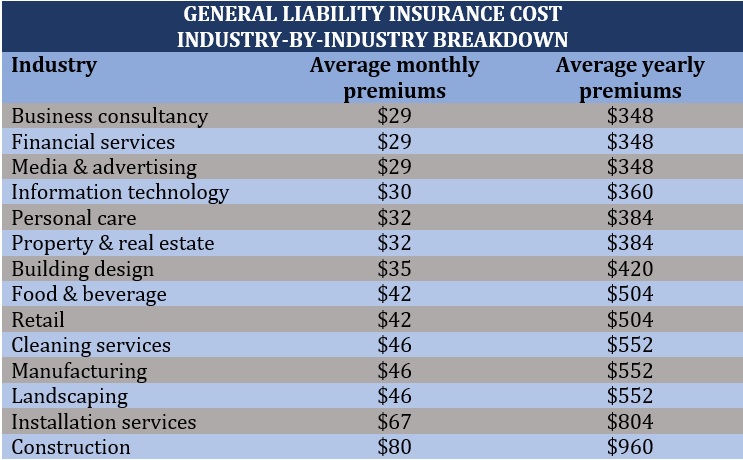

General liability insurance plays an essential role in keeping businesses financially protected if accidents involving clients and other third parties threaten to derail their operations. That’s why it’s always advisable for companies to take out this form of coverage regardless of their size and the industry they’re in. But how much does general liability insurance cost?
In this article, Insurance Business crunches the numbers to find out how much premiums cost for this type of policy. We will also delve deeper into the factors that affect pricing and explain how rates are calculated.
If you’re working out how much coverage your business needs and how much this will cost you, then you’ve come to the right place. Read on and find out everything you need to know about general liability insurance costs in this guide.
The average cost of general liability insurance for small businesses ranges from $40 to $55 monthly or $480 to $660 per year based on the various price comparison and insurer websites Insurance Business has checked out.
Since the risks that companies face vary greatly depending on a range of factors, their premiums can also be significantly higher or lower than these figures.
While the estimated average cost of general liability insurance our research found may not seem that high at first glance, it’s important to note that the actual premiums a business will need to pay may go well above or below that amount, depending on the following factors:
Different industries present varying levels of risks which have a corresponding impact on general liability insurance costs. For example, office-based businesses that don’t experience a lot of foot traffic such as financial and IT consultancies pay lower premiums compared to retailers – which customers frequent and face a greater likelihood of injuries.
Another example is construction and landscaping services which pose a higher risk of property damage.
The table below lists the estimated monthly and annual premiums for general liability coverage for businesses in different industries.

The more employees a business has, the higher the cost of general liability insurance. From an insurance perspective, each staff member carries a certain level of risk. A taxi fleet with 20 or more drivers, for instance, has a higher likelihood of getting involved in an accident compared to a transport service company with five drivers.
When it comes to policy limits, there are two figures that have a huge impact on general liability insurance costs. These are:
Per-occurrence limits are typically pegged at $1 million, while aggregate limits are usually set at $2 million. These figures can be adjusted depending on the needs of the business. The higher the limits, the higher the premiums and vice versa.
Each claim can raise general liability insurance costs come renewal time. Insurance companies view businesses that have faced lawsuits and filed claims to cover their losses as risky and will tend to charge them higher premiums to offset potential future losses.
Businesses based in areas with higher crime and accident rates are more likely to have costlier premiums than their counterparts in safer locations.
The deductible is the amount that businesses must pay out for an insured loss before coverage kicks in. Generally, the higher the deductible, the lower the premiums as the insurer assumes less risks. If you want to find out how this insurance component works, you can check out our comprehensive guide to insurance deductibles.
Here’s a summary of the different factors that affect general liability insurance costs.

Insurance companies typically determine how much premiums a business must pay using a rating system developed by different organizations, including:
There are also some insurers that follow their own classification systems. What these rating systems have in common is the use of class codes to determine how much risk a line of business presents.
In essence, general liability class codes work the same as job classification codes in workers’ compensation insurance. However, instead of indicating the risks associated with a particular job, general liability class codes reflect the risks a certain business faces.
Apart from this, these codes – which consist of three to six digits depending on the ratings agency – enable insurers to identify what types of coverage a business needs or doesn’t need, so they can come up with an appropriate pricing for the policy.
Although general liability insurance policies are not that expensive, there are still ways for you to slash your premiums. These include:
General liability insurance – also referred to as business liability or public liability insurance – protects your business financially against claims of bodily injury or property damage resulting from your business activities.
Most policies also include product liability coverage, which covers lawsuits from customers claiming losses or injury because of a product you manufacture or sell.
General liability policies may likewise provide coverage for copyright infringement and incidents that cause reputational harm, including:
If your business has been accused of causing these types of harm, general liability insurance will cover the legal and settlement costs involved. Such policies may also cover medical expenses incurred due to injuries that occur within the business’ premises, regardless of who is at fault or whether a lawsuit has been filed.
General liability insurance is not legally required for you to operate a business in the US. However, some clients, stakeholders, and suppliers may make this type of coverage a condition for doing business with you.
Although some businesses face greater liability risks than others, it is always advisable to purchase general liability coverage as it provides financial cushion in the event your business is sued because of an unexpected accident. General liability insurance is a crucial form of protection if your business:
Each business faces its own share of unique risks and challenges. Because of this, general liability insurance alone is not enough to provide complete coverage. Here are the other types of policies that your business needs to ensure that you are covered for any unexpected incident:
Business insurance plays a vital role in providing your business with financial protection from unexpected events that can otherwise cost you several thousands, if not millions, in income, making it difficult for you to recover. If you want to find out how this form of coverage can help you navigate difficult times, you can check out our comprehensive guide to business insurance in the US.
On average, an insurance policy that offers coverage for up to $2 million can cost about $30 a month in premiums.
Don’t celebrate yet, your business insurance cost is not a case of one size fits all. The cost of an insurance policy of this much coverage can vary. Depending on certain factors, a business may have to pay upwards of $100 a month for this much coverage.
The cost of premiums is based on important factors like:
the location of the business
the size of the annual revenue and its payroll
the size of the property where the business is located
the term length
the business’s claims history
A general liability insurance policy covers costs of incidents or damages, such as property damage or bodily harm. This covers damages only if they are related to business operations. This can include damage caused by the products or services that the business provides.
In most cases, general liability insurance takes care of the costs of settling legal issues that may arise, along with medical expenses for injuries sustained within the business premises. The policy can also cover these expenses even though no lawsuits are filed, regardless of who is at fault for the injuries.
Unusual cases or damages where liability insurance applies
Apart from the usual damages that a business may incur during normal operations, some insurance companies have become creative and expanded their coverage to more “unusual” damage, such as coverage for workplace violence.
A startup cost is defined as an expense that a business incurs even before earning any revenue. Getting business insurance from the very start is advisable. So yes, business insurance is considered a startup cost – at least when a business gets insurance before it officially starts operating and earning revenue.
As with most business insurance, there is no hard-and-fast rule to determine the exact cost of business insurance, even for a startup.
The cost of business insurance can vary. This depends on several factors such as the type of industry, size of the business, the nature of the operations and its risks, and the cost and term of coverage. The only way to know is to work with an insurance provider and get a quote.
Is business insurance only acquired at the start of a business?
Later, you may choose or have to take out more insurance policies to cover damages specific to your industry, such as insurance against cybersecurity threats.
Many professional service businesses like IT firms, payment systems or any other businesses that want to protect against cybersecurity threats aren’t taking chances. They have taken on cybersecurity insurance as their business grows and branches out to include e-Commerce transactions.
In general, yes. However, certain conditions must be met to legally deduct business insurance premiums from taxes. Business insurance must be both “ordinary” and “necessary” to the business.
Business insurance is “ordinary” if it’s used by other businesses in that industry. For example, an auto dealership would likely have collision insurance, since that’s what other auto dealerships would have as well.
On the other hand, business insurance is “necessary” if it’s reasonably helpful for business operations. “Necessary” business insurance doesn’t mean it’s a strict legal requirement. One example is malpractice insurance for lawyers, which is needed (but not legally required unless state law says otherwise) and therefore tax-deductible.
Tax-deductible types of business insurance
Tax-deductible business insurance includes these types discussed earlier:
general liability insurance
professional liability insurance
commercial property insurance
commercial auto insurance
business interruption insurance
Self-employed health insurance is also tax deductible. As self-employed individuals pay for the full cost of the premium, they can and should proclaim it as a tax deductible.
While both policies are the most common insurance options for small businesses, they have significant differences (apart from the million-dollar disparity). For starters, the cost difference between a $1 million liability and a $2 million liability is about $5 to $20 more in premiums paid each month.
Some insurance providers may advise individuals or businesses to keep to a policy with a $2 million liability. The number of claims and their costs over the year can reach the $1 million mark, especially for business insurance in a high-risk industry.
Choosing the $1 million liability coverage over the $2 million one can spell the difference of paying hundreds of thousands of dollars in exchange for saving only a few dollars on premiums per month.
In terms of auto insurance policy, $2 million is the ceiling for an individual. Though it is possible to raise the personal liability coverage to as much as $5 million, the way to do this is to pair the policy with an umbrella insurance policy to cover the exceeding amounts.
How much liability is enough?
A good rule of thumb is to have liability insurance that’s sufficient to cover your net worth. Calculate your net worth, add up the value of all the cash, investments, and assets that you own, then subtract that amount from your total liabilities. The resulting number is how much you need in coverage. But when in doubt, always consult an insurance provider for the quote that works for you.
Given how much general liability insurance costs, do you think it is a worthwhile investment? Is this type of coverage enough to protect your business? Feel free to share your thoughts in the comments section below.
